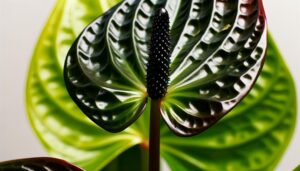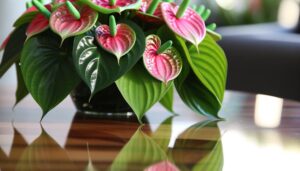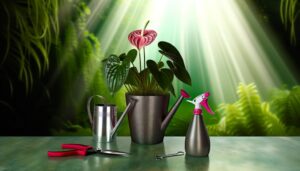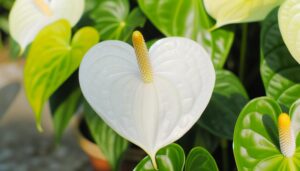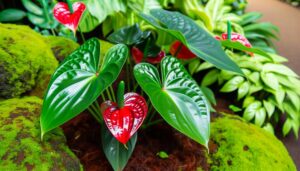Home Care Tips for Anthurium ‘Red Crystal’- A Guide!
Guarantee your Anthurium ‘Red Crystal’ thrives by providing bright, indirect light with 2000-2500 foot-candles, using grow lights if necessary.
Water when the top inch of soil is dry, using room-temperature, filtered water and maintaining 60-80% humidity.
Use a well-draining potting mix of orchid bark, perlite, and peat moss. Keep temperatures between 65°F and 80°F, use humidifiers, and mist foliage to maintain moisture.
Address yellowing leaves and aphids with insecticidal soap and maintain proper drainage to prevent root rot. For a deeper understanding, there are further details available that will help you master Anthurium care.
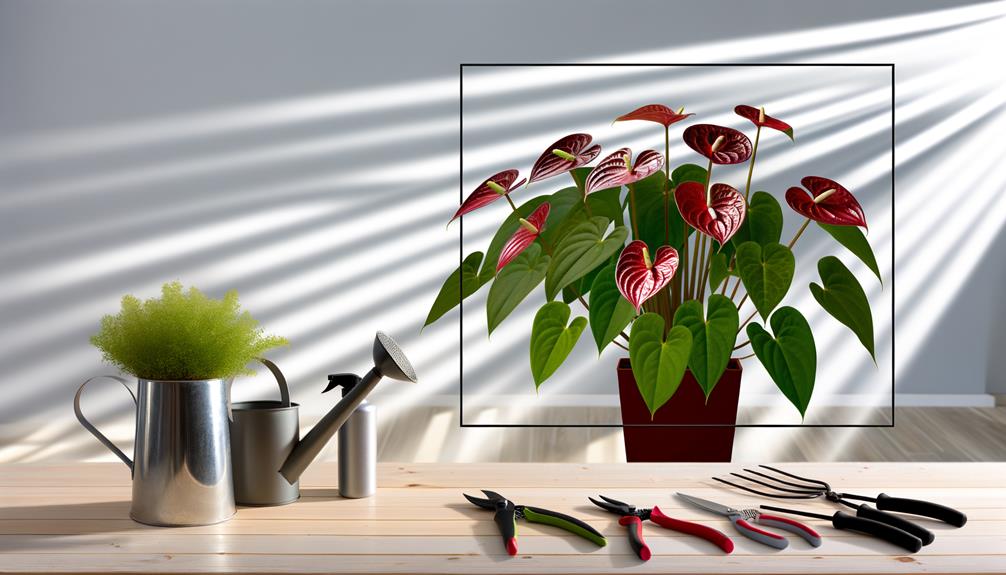
Key Takeaways
- Place Anthurium ‘Red Crystal’ in bright, indirect light near east or north-facing windows.
- Water every 1-2 weeks when the top inch of soil is dry, using room-temperature, filtered water.
- Use a well-draining potting mix with orchid bark, perlite, and peat moss for optimal growth.
- Maintain temperatures between 65°F and 80°F, and humidity levels between 70-80%.
- Regularly inspect for pests, ensure proper drainage, and avoid over-fertilizing to prevent common issues.
Ideal Lighting Conditions
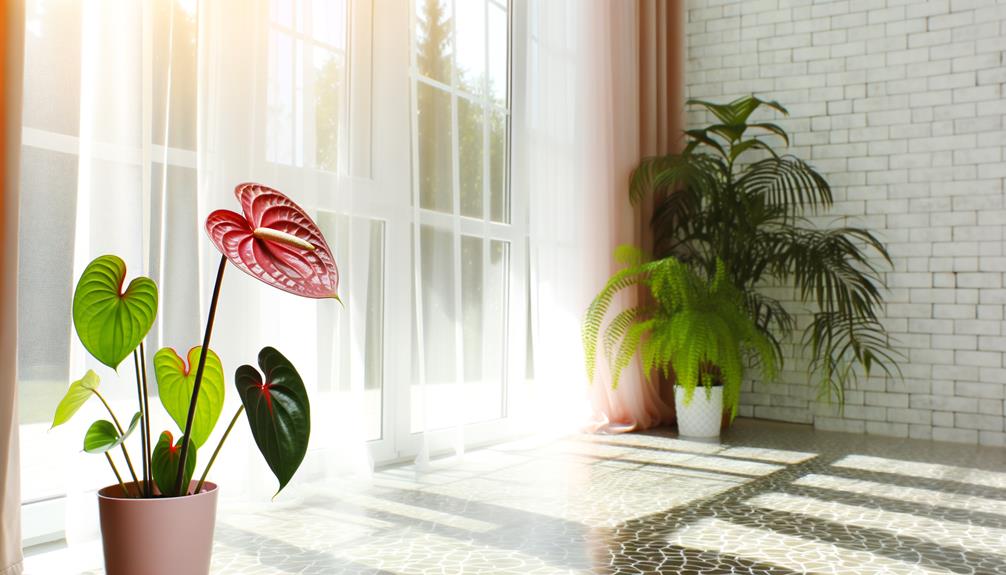
For best growth, make certain your Anthurium ‘Red Crystal’ receives bright, indirect light to replicate the dappled sunlight of its natural rainforest habitat.
Position it near an east or north-facing window, where it can absorb ample light without direct exposure, which could scorch its leaves.
If natural light is inadequate, consider using a grow light with a spectrum tailored for tropical plants. Maintain the light intensity measures around 2000 to 2500 foot-candles for peak photosynthesis.
Rotate your plant periodically to encourage even growth and prevent leaning. Remember, insufficient light can lead to leggy growth and reduced flowering, while excessive light will cause leaf burn. Your careful management of light conditions will optimize your Anthurium’s thriving beauty.
Watering Guidelines
Proper watering is essential for maintaining the health of your Anthurium ‘Red Crystal,’ ensuring the soil remains consistently moist but never waterlogged.
You’ll want to water when the top inch of soil feels dry to the touch. Use room-temperature, filtered water to avoid shocking the roots with cold or chemical-laden water.
- Frequency: Water every 1-2 weeks, adjusting based on the season and humidity.
- Method: Water thoroughly until excess drains from the bottom, ensuring even distribution.
- Humidity: Maintain a humidity level of 60-80% to mimic its tropical habitat.
Avoid letting the plant sit in standing water, which can lead to root rot. Monitor carefully, and adjust based on environmental changes to keep your plant thriving.
Soil and Potting Mix

For an ideal growing environment, you’ll want to focus on the perfect soil composition for your Anthurium ‘Red Crystal’.
A well-draining potting mix that includes ingredients like orchid bark, perlite, and peat moss will guarantee proper aeration and moisture retention.
These components create a balanced medium that mimics the plant’s natural habitat.
Ideal Soil Composition
Anthurium ‘Red Crystal’ thrives best in a well-draining potting mix composed of equal parts orchid bark, perlite, and peat moss to guarantee ideal root aeration and moisture retention.
This specific blend mimics the plant’s natural tropical environment while:
- Optimal Drainage: Prevents waterlogging, which can lead to root rot.
- Aeration: Allows roots to breathe, promoting healthy growth.
- Moisture Retention: Maintains consistent moisture levels without becoming soggy.
Orchid bark provides structural integrity and air pockets, perlite ensures drainage and lightweight texture, and peat moss retains moisture while remaining breathable.
When you use this mix, your Anthurium ‘Red Crystal’ will flourish, showing off its vibrant red spathes and lush foliage. Keep this balance to maintain the plant’s health and essentiality.
Potting Mix Ingredients
Choosing the correct potting mix ingredients is crucial to ensuring the optimal growth and health of your Anthurium ‘Red Crystal’.
Start with a base of orchid bark, which guarantees excellent aeration and drainage. Incorporate sphagnum peat moss to retain moisture while providing an acidic pH that anthuriums thrive in. Add perlite to enhance drainage and prevent root rot.
A small amount of charcoal can be beneficial to absorb toxins and keep the mix fresh. Finally, include a bit of coco coir for its moisture-retaining properties and sustainability.
Combine these ingredients in roughly equal parts to create a balanced, well-draining mix that mimics the plant’s natural epiphytic environment. This mix will promote robust root development and lush foliage.
Temperature Requirements
Maintaining the correct temperature for Anthurium ‘Red Crystal’ is essential for its health and growth. You should keep the temperature between 65°F and 80°F, as this range mimics its natural tropical environment.
Avoid exposing the plant to temperature extremes, as fluctuations below 55°F or above 90°F can cause stress and inhibit proper development.
Ideal Temperature Range
To maximize growth, keep the temperature for Anthurium ‘Red Crystal’ between 65°F and 80°F. This temperature range ensures best metabolic processes and encourages robust foliage and flower development. Precisely maintaining this environment will prevent thermal stress and support consistent growth.
Here are three specific actions you can take:
- Monitor Room Temperature: Use a digital thermometer to keep track of the ambient temperature.
- Adjust Heating/Cooling Systems: Fine-tune your HVAC system to maintain the ideal temperature range.
- Positioning: Place your Anthurium in a room where temperature fluctuations are minimal.
Avoid Temperature Extremes
Avoiding temperature extremes is crucial for the health of Anthurium ‘Red Crystal,’ as both excessive heat and cold can lead to cellular damage and inhibit growth. Keep your plant in a stable environment, maintaining temperatures between 65°F and 80°F.
Sudden temperature drops below 60°F can cause stress, hindering metabolic functions. Likewise, temperatures above 90°F can accelerate transpiration and dehydrate the plant. Don’t place your Anthurium near drafts, air conditioners, or heaters, as fluctuations can disrupt its delicate balance.
Use a thermometer to monitor indoor climate and maintain consistency. A humidifier can help stabilize conditions, especially during winter.
By managing temperature, you’ll promote robust growth and vibrant blooms, ensuring your Anthurium ‘Red Crystal’ thrives.
Humidity Levels

How significant is it to maintain ideal humidity levels for Anthurium ‘Red Crystal’?
It’s essential for their lush growth and vibrant blooms. Anthuriums thrive in a humid environment, ideally between 70-80% humidity. Low humidity can cause leaf browning and reduced vigor.
To guarantee your plant stays healthy, consider:
- Humidifiers: Use a humidifier to consistently uphold the appropriate moisture levels.
- Misting: Regularly mist the foliage with distilled water; avoid tap water due to mineral buildup.
- Pebble Trays: Place the pot on a tray filled with water and pebbles, making sure the pot’s base doesn’t touch the water.
Fertilization Tips
Best fertilization is important for ensuring Anthurium ‘Red Crystal’ receives the necessary nutrients for strong growth and vibrant blooms.
You should use a balanced, water-soluble fertilizer with an N-P-K ratio of 20-20-20. Dilute the fertilizer to half-strength to avoid over-fertilization, which can damage the roots.
Apply the solution every six to eight weeks during the growing season, typically from spring to early fall.
Be mindful that excessive fertilization can lead to salt build-up in the soil, potentially causing leaf burn. To prevent this, flush the soil with water every few months.
Pruning and Maintenance
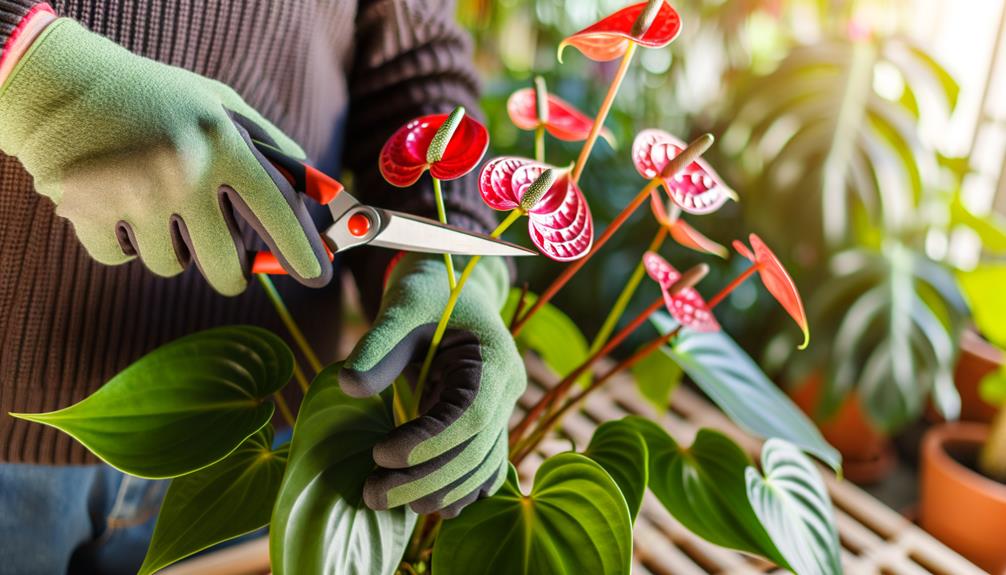
In addition to proper fertilization, regular pruning, and maintenance are essential for promoting healthy growth and preventing disease in Anthurium ‘Red Crystal’.
Begin by using sterilized pruning shears to remove any yellow or brown leaves, as these can harbor pathogens.
Trim spent flowers to direct the plant’s energy towards new growth.
Pay close attention to the following:
- Deadheading: Remove faded blooms to encourage continuous flowering.
- Leaf Pruning: Cut away damaged or unhealthy leaves close to the stem.
- Sanitization: Always disinfect tools before and after use to prevent disease spread.
Common Pests and Issues
Anthurium ‘Red Crystal’ is susceptible to several common pests and issues, including spider mites, aphids, and root rot, which can significantly impact its health and growth.
You’ll often find spider mites on the undersides of leaves, causing stippling and yellowing. Treat them with insecticidal soap or neem oil.
Aphids, which suck sap, can be eradicated using a strong water jet or insecticidal soap.
Root rot arises from overwatering; guarantee well-draining soil and allow the top inch of soil to dry between waterings.
Regularly inspect your plant for early signs of infestation or disease. Early detection and prompt treatment are essential to maintaining the vibrancy of your Anthurium ‘Red Crystal’, safeguarding it remains a stunning feature in your home.
Conclusion
In caring for your Anthurium ‘Red Crystal,’ remember: ‘An ounce of prevention is worth a pound of cure.’
By optimizing lighting, watering, soil, temperature, humidity, and fertilization, you’ll secure robust growth and vibrant blooms.
Regular pruning and vigilance against pests will further safeguard your plant’s health.
With these scientifically-backed tips, you’re well-equipped to cultivate a thriving Anthurium ‘Red Crystal,’ transforming your space with its stunning beauty.

